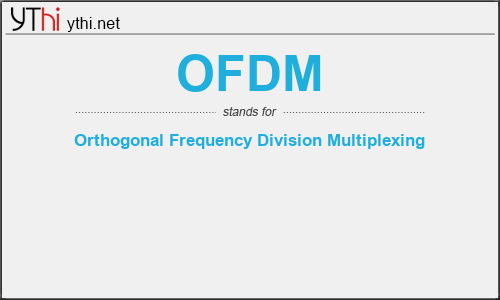What does OFDM mean? What is the full form of OFDM?
The Full Form of OFDM is Orthogonal Frequency Division Multiplexing.
OFDM is a form of multicarrier modulation. An OFDM signal consists of a number of closely spaced modulated carriers. When modulation of any form – voice, data, etc. is applied to a carrier, then sidebands spread out either side. It is necessary for a receiver to be able to receive the whole signal to be able to successfully demodulate the data. As a result when signals are transmitted close to one another they must be spaced so that the receiver can separate them using a filter and there must be a guard band between them. This is not the case with OFDM. Although the sidebands from each carrier overlap, they can still be received without the interference that might be expected because they are orthogonal to each another. This is achieved by having the carrier spacing equal to the reciprocal of the symbol period.
To see how OFDM works, it is necessary to look at the receiver. This acts as a bank of demodulators, translating each carrier down to DC. The resulting signal is integrated over the symbol period to regenerate the data from that carrier. The same demodulator also demodulates the other carriers. As the carrier spacing equal to the reciprocal of the symbol period means that they will have a whole number of cycles in the symbol period and their contribution will sum to zero – in other words there is no interference contribution.
One requirement of the OFDM transmitting and receiving systems is that they must be linear. Any non-linearity will cause interference between the carriers as a result of inter-modulation distortion. This will introduce unwanted signals that would cause interference and impair the orthogonality of the transmission.
In terms of the equipment to be used the high peak to average ratio of multi-carrier systems such as OFDM requires the RF final amplifier on the output of the transmitter to be able to handle the peaks whilst the average power is much lower and this leads to inefficiency. In some systems the peaks are limited. Although this introduces distortion that results in a higher level of data errors, the system can rely on the error correction to remove them.
OFDM, Orthogonal Frequency Division Multiplexing is a form of signal waveform or modulation that provides some significant advantages for data links.
Accordingly, OFDM, Orthogonal Frequency Division Multiplexing is used for many of the latest wide bandwidth and high data rate wireless systems including Wi-Fi, cellular telecommunications and many more.
The fact that OFDM uses a large number of carriers, each carrying low bit rate data, means that it is very resilient to selective fading, interference, and multipath effects, as well providing a high degree of spectral efficiency.
Early systems using OFDM found the processing required for the signal format was relatively high, but with advances in technology, OFDM presents few problems in terms of the processing required.
The use of OFDM and multicarrier modulation in general has come to the fore in recent years as it provides an ideal platform for wireless data communications transmissions.
However the concept of OFDM technology was first investigated in the 1960s and 1970s during research into methods for reducing interference between closely spaced channels. IN addition to this other requirements needed to achieve error free data transmission in the presence of interference and selective propagation conditions.
Some of the first systems to adopt OFDM were digital broadcasting – here OFDM was able to provide a highly reliable form of data transport over a variety of signal path conditions. Once example was DAB digital radio that was introduced in Europe and other countries. It was Norwegian Broadcasting Corporation NRK that launched the first service on 1st June 1995. OFDM was also used for digital television.
Later processing power increased as a result of rising integration levels enabling OFDM to be considered for the 4G mobile communications systems which started to be deployed from around 2009. Also OFDM was adopted for Wi-Fi and a variety of other wireless data systems.
OFDM
means
Orthogonal Frequency Division Multiplexing![]()
Translate Orthogonal Frequency Division Multiplexing to other language.


Leave a Reply
You must be logged in to post a comment.